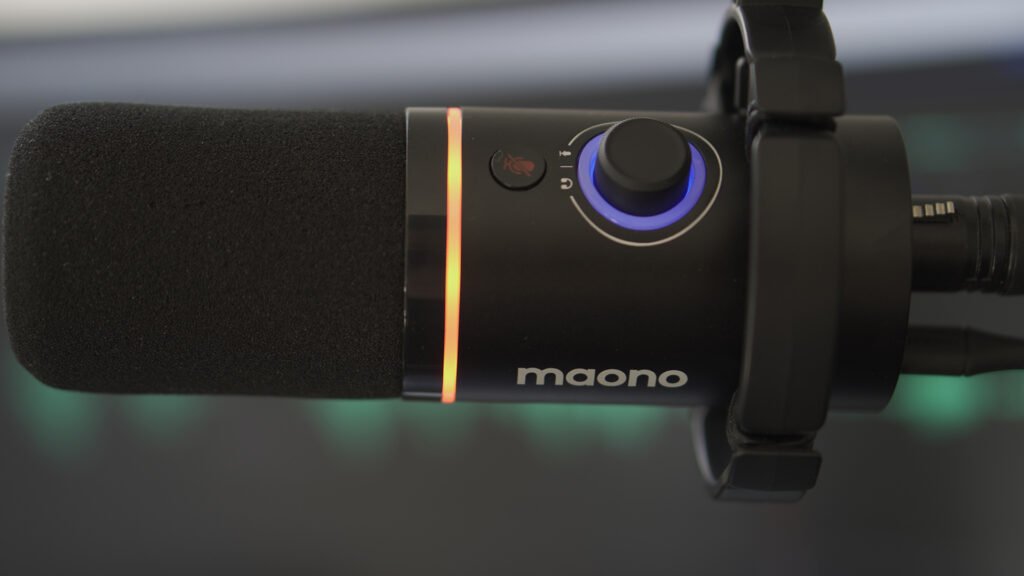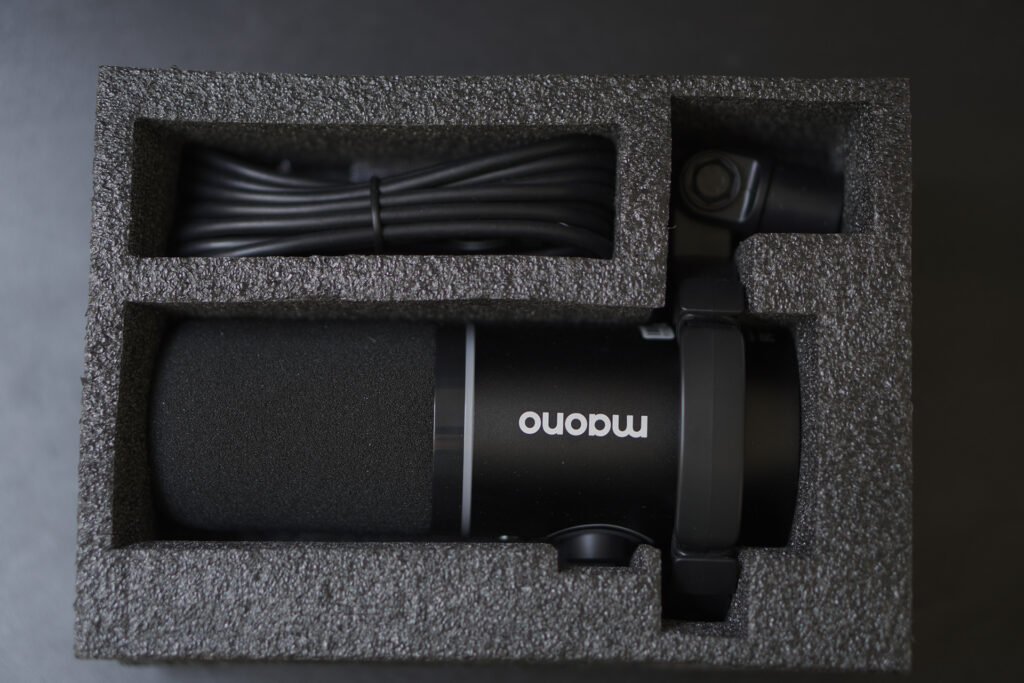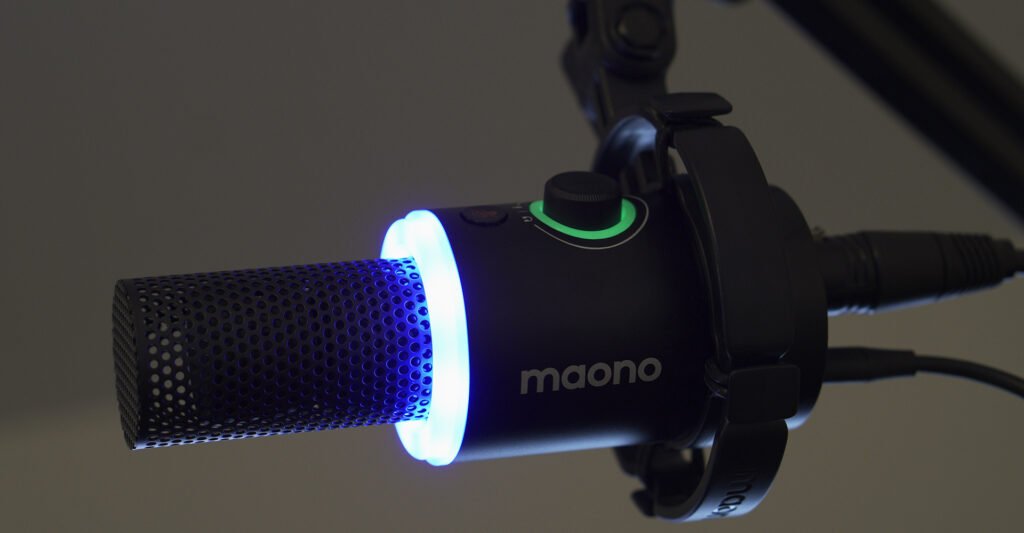Maono PD200X is a dynamic microphone with lots of features and XLR/USB connection released in early 2023 by MAONO, a Chinese brand, founded in 2014. The company focuses on audio related gear and sells microphones, audio interfaces, headphones and accessories. A lot of their products are easy to install, feature RGB color effects and prices affordable even on a tight budget making them a good choice for entry-level content creators and gamers.

What’s in the box?
In Maono PD200X box you’ll receive the following:
- Maono PD200X microphone
- Shock mount
- 5/8” to 3/8” adapter
- 2.5m (8.2ft) USB-C to USB-A & USB-C cable
- Manual

Maono PD200X Specifications
| Connection type | XLR/USB |
| Element type | Dynamic |
| Pattern | Cardioid |
| Self-noise | – |
| Frequency response | 40Hz -16,000Hz |
| Sensitivity | 2.5mV/Pa (-52dB) |
| Weight | – |
| Max SPL | 130dB SPL |
Maono PD200X is advertised as a microphone with ultra-wide frequency response of 40Hz-16,000Hz, which is decent for a ~80$ microphone. However, you can find microphones with 20Hz-20,000Hz or even 20Hz-22,000Hz frequency response and they rarely claim to have ultra-wide frequency response, hence it’s more of a marketing trick. Not that frequency response matter that much, as you most likely won’t be able to hear anything below 40Hz or above 16,000Hz anyway and such range is fine for almost any application.
The microphone has a cardioid polar pattern, which is very common among microphones and good for background noise rejection.
The sensitivity of -52dB is relatively high for a dynamic microphone and a very pleasant surprise, you’ll probably be able to drive this microphone even with cheaper audio interfaces and their built-in pre-amps.
Weight is not displayed by the seller, but this microphone is super lightweight, you won’t have trouble using any sort of swivel arm or stand with it.
Sound quality
I haven’t edited any of these recordings and used about 80% of my Midas pre-amp in XLR mode and max mic volume in USB mode.
The microphone sounds different in XLR and USB modes, nevertheless, for the low price you pay I found it to sound really good which surprised me. When using an XLR connection, it seems that the microphone has enhanced low end and sounds a bit warmer. On the other hand, in USB mode it sounds more airy and has more mid to high-end frequencies, which gives more clarity and vibrance to vocals.
I noticed that in USB mode it picks up significantly less of the background noise coming from my PC fan. I suspect that’s because with the XLR connection microphone picks up more of the low-end, which is where the fan noise resides. I also notice that PD200X seems to pick up more plosives while in USB mode compared to XLR.
XLR mode:
USB mode:
Features
Maono PD200X is packed with the following features:
- Adjustable RGB Lighting (8 colors and a rainbow mode)
- Both XLR and USB connection
- Headphones connection for real-time playback
- Adjustable gain and headphones volume
- Dedicated pop-filter
- Mute button
- Dedicated software
Keyboard noise rejection
Maono PD200X XLR background noise rejection:
Maono PD200X USB background noise rejection:
For my ears, PD200X picks up quite a bit of higher frequencies coming from the background which makes the keyboard much more noticeable, especially if you’re using a mechanical keyboard. This might be less of a problem with membrane keyboards.
For comparison below is keyboard noise picked by Rode Procaster which has a very good background noise rejection, however, sells for almost three times as much.
Rode Procaster background noise rejection:
Build quality

The microphone body is all metal and seems sturdy enough to withstand traveling or a bit of a beating. The gain knob and buttons are plastic and a bit flimsy, I would prefer it if they were metal as well, but I suppose they had to cut costs somewhere. The capsule grill covered by the detachable pop-filter is all metal and feels solid, I am surprised the microphone is so light considering that almost everything is metal.
Design
The design of this microphone is modern, clean looking and very compact. You can get the microphone in either black or white colors. I like that you have the option to switch between RGB modes and have it turned off if required.
The RGB works only with the USB cable connected, however, you can use the XLR version of the microphone with RGB lighting activated if you have both XLR and USB cables inserted.
You can switch between adjusting the microphone gain and headphones volume by pressing the knob. A green light indicates a microphone pre-amp, while blue represents headphone volume. A brighter color indicates higher gain/volume and vice versa, upon reaching maximum or minimum gain/volume it starts blinking. It would have been nice if they included graded indication as well, but it’s not a deal breaker as I would probably have it at maximum all the time anyway.
Value
In my opinion, Maono PD200X is a great value for money choice considering that it includes a shock mount and pop filter, has a surprisingly good audio quality for the price and packs lots of features such as a mute button, real-time monitoring and RGB that might attract someone intending to use the microphone on-camera or live. I only wish they included some sort of microphone stand to make it easier for someone starting in content creation.
Who’s it for?
I would suggest acquiring Mano PD200X if you are new to content creation and want to start a podcast or a YouTube channel. The microphone might also be suitable for gaming if you don’t care much about recording the keyboard noise.
Pros and cons
| Pros: | Cons: |
| XLR/USB connection | No microphone stand |
| RGB lighting | Flimsy buttons |
| Low price | Sensitive to keyboard noise |
| Good audio quality | |
| Pop-filter and shock mount included | |
| High sensitivity | |
| Easy to install | |
| Dedicated software |
Overview
Maono PD200X is a good entry-level microphone, offering both XLR and USB connection, which creates an opportunity to upgrade from USB to XLR if this is your first microphone. Compared to similarly priced microphones it offers good audio quality, a metal body and lots of features that may be tempting for someone intending to use the microphone live and/or on-camera.
I love that this microphone has high sensitivity making the microphone compatible with less powerful and cheaper pre-amps if you intend to use it with an XLR connection.
You’ll need a microphone stand or swivel arm to fully set up this microphone, however, with a USB connection you can easily just plug and play it.
